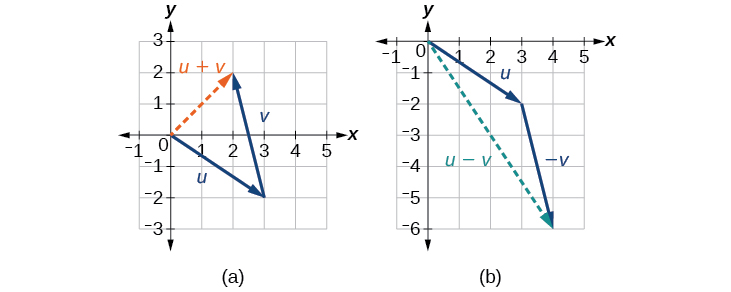| << Chapter < Page | Chapter >> Page > |
To find u + v , we first draw the vector u , and from the terminal end of u , we drawn the vector v . In other words, we have the initial point of v meet the terminal end of u . This position corresponds to the notion that we move along the first vector and then, from its terminal point, we move along the second vector. The sum u + v is the resultant vector because it results from addition or subtraction of two vectors. The resultant vector travels directly from the beginning of u to the end of v in a straight path, as shown in [link] .

Vector subtraction is similar to vector addition. To find u − v , view it as u + (− v ). Adding − v is reversing direction of v and adding it to the end of u . The new vector begins at the start of u and stops at the end point of − v . See [link] for a visual that compares vector addition and vector subtraction using parallelograms .

Given and find two new vectors u + v , and u − v .
To find the sum of two vectors, we add the components. Thus,
See [link] (a) .
To find the difference of two vectors, add the negative components of to Thus,
See [link] (b).

While adding and subtracting vectors gives us a new vector with a different magnitude and direction, the process of multiplying a vector by a scalar , a constant, changes only the magnitude of the vector or the length of the line. Scalar multiplication has no effect on the direction unless the scalar is negative, in which case the direction of the resulting vector is opposite the direction of the original vector.
Scalar multiplication involves the product of a vector and a scalar. Each component of the vector is multiplied by the scalar. Thus, to multiply by , we have
Only the magnitude changes, unless is negative, and then the vector reverses direction.
Given vector find 3 v , and − v .
Given and find a new vector w = 3 u + 2 v .
First, we must multiply each vector by the scalar.
Then, add the two together.
So,
In some applications involving vectors, it is helpful for us to be able to break a vector down into its components. Vectors are comprised of two components: the horizontal component is the direction, and the vertical component is the direction. For example, we can see in the graph in [link] that the position vector comes from adding the vectors v 1 and v 2 . We have v 1 with initial point and terminal point

Notification Switch
Would you like to follow the 'Algebra and trigonometry' conversation and receive update notifications?